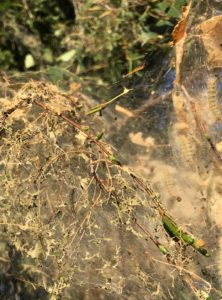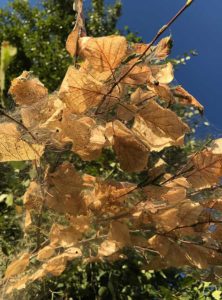Tent Caterpillars, Western
Latin name: Malacosoma fragilis, Malacosoma californicum
Size: 2″ long
Color: Caterpillars have golden and black stripes and golden hairs
Life cycle: The female moth stage of tent caterpillars lays masses of up to 400 eggs and covers them with a coating. Caterpillars go through five larval stages prior to pupating and becoming a moth.
Symptoms of their activity: “Tents” of webbing that encompasses several branches, dead leaves within the webbing. On close inspection, you will see all sorts of caterpillars moving about (click on photo to right and look at upper right corner). The webbing helps protect the caterpillars from some predators.
Typically seen on: Tent caterpillars are mostly seen on trees such as crabapples, apples, pears, peaches, plums, cherries and aspens; also roses.
Controls: Damage is primarily aesthetic, so just remove (and dispose of, do not compost!) the affected areas of the plant.
Cultural controls: None.
Natural predators: Yellow jackets, parasitic wasps, predatory beetles, some naturally-occurring viruses and bacteria.
Additional information: Washington State University Western Tent Caterpillar
Back to Organic Pest Control


